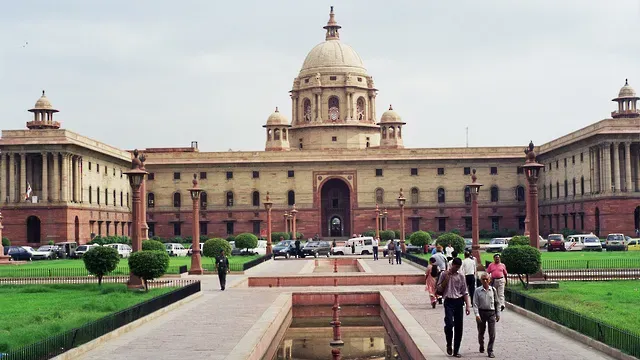The Weekend Read: India's global grid dream
In conversation with Amit Jain, Senior Energy Specialist with the World Bank

Welcome to this weekend’s edition of Lights On, a newsletter that brings you the key stories and exclusive intel on energy and climate change in South Asia.
India’s dream of a global grid delivering clean energy to 140 countries inches closer to becoming reality. According to a draft plan released last year, the One Sun, One World, One Grid (OSOWOG) project will connect countries through a solar powered network “across the far east and the far west regions, to build consensus, launch energy policy imperatives and set up a framework for such a global cooperation.” It will do so in three phases, connecting South Asia, the Middle East and Southeast Asia first, then reaching the African continent and finally the world.
After a hiatus of nearly three years since the project was launched in October 2018, India is picking up where it left off. Over the past few weeks, the government has set up a team dedicated to bolstering energy cooperation across the region and supporting the OSOWOG vision, and it has tasked the French public utility Électricité de France SA (EDF) with the design of its implementation roadmap.
Until the final plan is out in the open, big questions remain: is the idea really feasible? What are its technical and political implications? I spoke with Amit Jain, a Senior Energy Specialist with the World Bank who has been involved in the project since its inception, to answer some of the most pressing.
Lights On: Where does the idea of a global grid come from? Are there any precedents to such a project?
Amit Jain: The concept of intercontinental grids is not new. For example, a plan to transfer energy from Africa to Europe [had been devised], but because of several reasons, mainly geopolitical, it couldn't go ahead. Recently, the company Sun Cables also announced plans to connect Australia to Singapore through a 1,600km line.
But it was at the first International Solar Alliance assembly [in 2018] that honorable Prime Minister Modi announced the concept of One Sun, One World, One Grid. Since then, we have been working very closely with the Ministry for New and Renewable Energy (MNRE) and the International Solar Alliance (ISA) on this concept. After the project was formally approved during the third ISA assembly, a partnership agreement was signed between the World Bank, MNRE and ISA, just to put a formal stamp on how we could work together. A tender has already been launched by MNRE and ISA to hire a consultant to work on our vision and roadmap.
[Since this interview, a consultant has been hired: the French Électricité de France (EDF) will lead a consortium to design the roadmap]
I am sure many people will be asking how feasible this idea really is. I know it’s meant to be rolled out in three phases and not all at once, but how much of this project is vision, and how much is achievable in practice?
The OSOWOG idea is based on three pillars. One is expertise in high voltage DC [direct current] cables. Now, the technology has been around for several years and in several countries across the globe, including Europe, China and also India, which has thousands of kilometres of HVDC [high voltage direct current] lines. Secondly, the plan is based on smart minds, experts from all across the world have come together to see if it is commercially feasible. And the third pillar is ‘smart grid electron’: we make sure that all the electrons passing through this one grid, if it happens in future, will be driven by renewables and storage. So renewable energy is commercially and financially available, a grid is also technically possible, and we [already] have global exports.
Ok, the plan is technically feasible. But is it going to be too expensive as the world still reels from the impacts of the Covid crisis? Is it possible that this idea is too premature?
This is the exact question we all want to answer through the study we are going to commission. A future roadmap is going to tell us exactly if the three phases [we envisage] are practical. So, we are at a very conceptual stage right now, where we don't want to jump to conclusions. Let the study come out, and we will come to see if it’s commercially viable. If everything goes well, we should have a first draft by July or August this year.
Can you tell me a bit more about the technical aspects of this potential implementation? I imagine it will start small?
The phases you mentioned involve connecting India with Southeast Asia first, secondly connecting India with the Gulf and thirdly India with Africa. Now, if you look at the existing scenario, India only is connected via grid to Nepal, Bhutan and Bangladesh. And there are other initiatives by the government of India to strengthen this. What this new study will ask is, can we extend this to Southeast Asia, let's say via Myanmar, in addition to South Asia? Similarly, as you know, there's a lot of desert in Rajasthan and [the coastal state of] Gujarat, and solar radiation is also very high. So it is natural for a country like India to install large scale solar and wind in these two states. So, this study will also check whether it is technically and commercially feasible to have undersea cables from India to Oman and the Gulf.

OSOWOG aims to connect Western Indian states to Oman
Let’s take the example of Rajasthan. As you pointed out the state is ideal for solar because it has a lot of cheap land, and lots of sun. But solar development is not always smooth - a solar park can be built quickly, while the connectivity infrastructure can take much longer to set up, leaving the solar plants disconnected for as long as it takes to build the grid. Is this a potential problem you are taking into account?
This is a question that the study is trying to answer. Globally, and in India, sometimes there's a mismatch between the solar part coming up and [grid] upgrading. The transmission takes 18 months minimum, and the solar park can come up in six to 12 months. So there is a natural gap in the construction of these two technologies. Now when in the future, let's say 10 to 20 GW of projects come up in Rajasthan, either you can transfer this forward to Delhi or to Maharashtra, because these are [high] demand centers. That's where your question is very relevant: do we have the transmission network and to transfer this forward, is it technically and commercially feasible to have an undersea cable from Rajasthan and Gujarat to the Gulf? Bear in mind that we already have oil pipelines, so it is historically possible to transfer oil, and also optical fiber. The concept of transferring materials and goods across different continents is not new.
When planning the intercontinental transfer of goods, the technical aspect is only one part of the story. What will be the geopolitical implications of the OSOWOG project? Would it be fair to say, like many are suggesting, that it’s India’s response to China’s Belt and Road Initiative?
I think this question is best answered by the government.
Critics of this project say that the future of clean energy shouldn’t be a global grid, but rather a decentralised system, where energy is produced and consumed locally. That would be less disruptive for local environments and more efficient in serving remote locations. What’s your opinion?
Completely agreed, decentralised energy is the future. The World Bank is a big proponent of decentralised energy: in India, we have a $625 million program on rooftop solar. This is the largest existing program we have within the World Bank in India, much higher than other critical programs. And I would like to clear the misconception that grid distributed and decentralised solar are in competition - in fact they complement each other.
Let's bear in mind that the OSOWOG initiative includes both grid-distributed and decentralised solar. Decentralised energy has been given extreme prominence in the tender, because that's what is happening in Germany. That's what's happening in California. Decentralised energy, especially rooftop solar, is the future because the prices have come down, and it will play an integral role in the OSOWOG initiative.
This interview has been lightly edited for length and clarity
That’s all for today! If you like what you read, please consider signing up for free or as a member:



